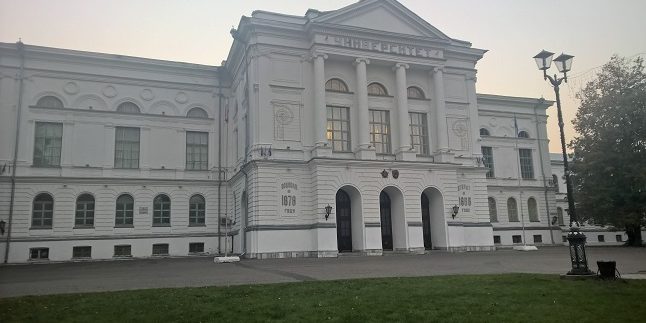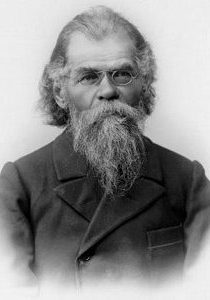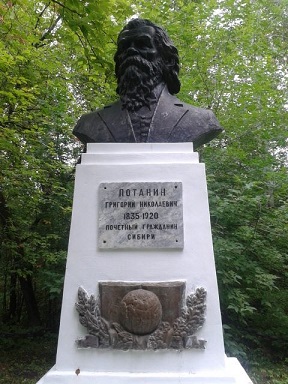Wisdom and Youth of the University Grove

History of TSU
Tomsk State University is the oldest university in the Russian part of Asia and one of three dozen Leading National Research Universities.
The establishment of TSU was initiated by the Imperial order signed by Emperor Alexander the First. The construction began on the 26th of August, 1880, and the opening was on the 22nd of July, 1888. Initially the university was called The Imperial Siberian University and consisted of 4 departments – physics and mathematics, medical, law, and history and philology.
Great men of the time were involved in the establishment of the university. Siberian merchants and manufacturers made financial contributions. The draft of the Siberian University Charter was made by the outstanding Russian scholar Mendeleev.
During Soviet times, the University developed rapidly. In 1928, the first largest center of physic research in Siberia – the Siberian physical technical institution – was opened. The Research Institute of Mathematics and Mechanics was opened in 1932, and the Biological Institute was opened in 1935.
During the Second World War, the TSU scientists developed a new defense system.
Later TSU played a critical role in the establishment of the Tomsk Academic Town.
(Source: The TSU History)
History of The University Grove
The University Grove is an essential part of TSU and one of the most interesting landmarks in Tomsk.
The scientist, Porphyry Krylov established the grove in 1885.
An important architectural element of the grove is the fence and trees planted along it, made in 1884, which forms the so-called Alexander’s Boulevard. It was named after the three Emperors – Alexander the First, Second and Third.
The stone idols hold a special place in the University Grove. They are tombstones of Old Turkic chiefs that lived from the 6th to 11th centuries. The majority of them were brought from Kazakhstan (the city of Verniy or Alma-Aty and the city of Karkaralinsk), and one was brought form Altay. However now, only two idols have been preserved.
Many of the students believe the idols can grant a wish. For example, students will leave sweets and coins close to it, or do a circle dance around it. This is done in hopes of receiving help to pass exams successfully. It is also a tradition to celebrate a wedding close to the idols. This is because there is a belief that the idols can facilitate a marriage.
Also, there are the graves of the outstanding botanist Porphyry Krylov and Lidia Sergievskaya. Krylov was a founder of the Siberian Botanic Garden, and Sergievksaya is a student of Krylov. She was an active explorer of Siberian vegetation.
(Source: Wikipedia)
The Potanin's monument
There is a grave and monument of the famous scientist and explorer – Grigoriy Potanin.
He was a Russian geographer, ethnographer, publicist, folklorist, botanist and one of the founders of the Siberian regionalism.
As the originator of the Siberian self-determination, he was out with both the monarchy and the young Soviet regime.
The Soviet government declared him a separatist and counter revolutionist, so the name of Potanin had been forgotten for a long time and his grave was lost.

Source: Wikipedia

Photo credit: Adele Lonas
It is interesting that the initiator of the establishing of the Potanin Monument was... Elizabeth the Second.
In the 1950s she asked the Soviet government how the name of Potanin was memorialized. The request was redirected to TSU, where Potanin used to work.
However, local history experts couldn’t say where the Potanin’s grave was located. But, as fortune would have it, they were able to find his grave. The director of the Tomsk Local History Museum – Nikolay Petrov and the expert Nikolay Slavnin found in holdings of the museum an old photo of the Potanin’s grave. The place where the grave was located was recognized by a remarkable birch.
As the result, Potanin was reentered in the University Grove in 1956. In 1958, the monument was raised on Potanin’s grave.
(Source: Wikipedia, Tomsk Review. Not the best known facts about well-known Tomsk's monuments)
Photo credit: Adele Lonas
Testimonials
My experience at TSU and the University Grove was a great break from Tomsk. Nestled within the university is a quiet sanctuary for the tired student or passerby. When you enter into University Grove, you will be engulfed in a vibrant array of greenery. Hidden throughout the Grove are statues that vary between historical figures to tribal idols. These idols and statues throughout the Grove are interesting to look at have a rich backstory. Watch out for the pack of wild dogs that roam the grove, they’ll kill you with cuteness!
Broc Bainter
TSU and the University Grove are special places in my Family's history.
My father and my grandmother graduated from TSU.
Despite the fact that I'm a TPU student, I love to spend my free time
in the University Grove. It is an island of trees and grass among the center of Tomsk, where it is possible hide from a hustle and bustle of the city.
Anastasiia Piletskaia
TSU is a special place for me because I finished the university in 2015. akes me proud of the fact that graduation. It makes me proud of the fact of termination of this university, because the TSU is a great university with a long history and great success in the field of science. I graduated from the Faculty of Radio Physics, Department of Quantum Electronics and Photonics. It was not very easy, but I am very grateful to this place for the great knowledge and the formation of my personality. Visit this place again was a real gift for me.
Elena Kharapudchenko
Location
Glossary
Leading National Research University is a higher educational institute, which carries out the educational and reseach activities equally successful on the basis of the principles of science and education integration (The Official Educational Portal of Russia).
Philology is the study of language; especially : the study of how languages or words develop (Merriam-Webster)
Dmitri Mendeleev was a Russian chemist and inventor. He discovered the periodic law and created the periodic table of elements. (biography.com).
Akademgorodok ( Russian: “Academic Town”) scientific research city (Britannica).
The Turkic peoples, any of various peoples whose members speak languages belonging to the Turkic subfamily of the Altaic family of languages (Britannica).
Ethnography is the study of human races and culture (Merriam-Webster)
Separatist is a member of a group of people who want to form a new country, religion, etc., that is separate from the one they are in now (Merriam-Webster)
Memorialize is to do or create something that causes people to remember a person, thing, or event (Merriam-Webster)
Authors
Broc Bainter. Currently pursuing a master's degree in awesomeness TESL/TEFL at CSU.
Anastasiya Piletskaya. Trying to escape the Matrix get a master's degree in Computer Science and Engineering at TPU.